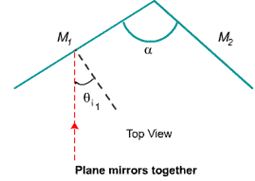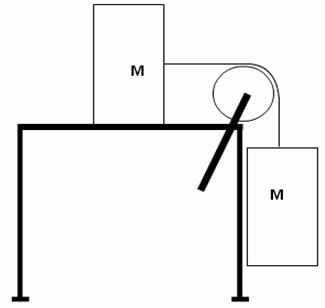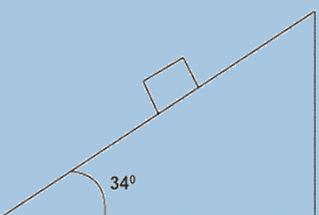Complete th following:
1: Two people stand 3.0 m away from a large plane mirror and are 5.0 m apart from each other in a dark room. At what angle of incidence should one of them shine a flashlight on the mirror so that the reflected beam strikes the other person at the same height that the flashlight is held? Assume the person with the flashlight holds it near his body? (Helpful tip: Treat this problem as a right triangle where 3 m is the length of the adjacent side and 2.5 m is the length of the opposite side (the length of the hypotenuse corresponds to the person's diagonal distance from the mirror). To find the angle, take the inverse tangent (tan-1 button on your calculator allows you to do this) of the opposite side divided by the adjacent side (i.e. tan-1[opposite/adjacent]).
2: Two plane mirrors, M1 and M2, are placed together as illustrated in the figure.
a. If the angle between the mirrors is 70o and the angle of incidence of a light ray incident on M1 is 35o, what is the angle of reflection from M2?
b. If the angle between the mirrors is 115o and the angle of incidence of a light ray incident on M1 is 60o, what is the angle of reflection from M2?

3: The laser used in cornea surgery to treat corneal disease is the excimer laser, which emits ultraviolet light with a wavelength of 193 nm in air. The index of refraction of the cornea is 1.376. What are the wavelength and frequency of the light in the cornea?
(Helpful tip: The speed of light (c) is equal to the frequency times the wavelength. To find the frequency, simply divide the speed of light by the wavelength in air (193 nm).To find the wavelength in the cornea, divide the wavelength in air by the index of refraction.)
4: A cube of flint glass sits on a newspaper on a table. By looking into one of the vertical sides of the cube, is it possible to see the portion of the newspaper covered by the glass?
5: A beam of light with red and blue components of wavelengths 670 nm and 425 nm, respectively, strikes a slab of fused quartz at an incident angle of 30o. On refraction, the different components are separated by an angle of 1.31 X 10-3 rad. If the index of refraction of the red light is 1.4925, what is the index of refraction of the blue light? (Helpful tip: Use Snell's Law to find the angle of refraction for red light. The blue component of this light is separated from the red by 0.075 degrees (I did the conversion for you). Add this amount to the angle you calculate for the red. Use Snell's Law again to calculate the index of refraction for the blue light in the same manner as the red.)
6: An opaque container is 15 cm deep. It contains only a single coin. When looking into the container at a viewing angle of 50o relative to
the vertical side of the container, you see nothing on the bottom. When the container is filled with water, you see the coin (from the same viewing angle) on the bottom of, and just beyond, the side of the container. How far is the coin from the side of the container? (Helpful tip: Use Snell's Law and solve for sin (theta-r). Next, take the inverse sin (use the sin-1 button on your calculator) to find the angle theta-r. Finally, take (15 cm)*tan(theta-r) to find the distance.)
7: If a certain amount of gas fills a 1 liter container and exerts a pressure on the walls of 2.0 N/m2 at 20 o C, What would the pressure theoretically be at absolutely zero Assume it is ideal gas and the container size remains constant.
A. 0.025 N/m2
B. Cannot tell because need to know the amount of gas.
C. Cannot tell because need to know what the gas is.
D. 0.050 N/m2
E. 0.0037 N/m2
8: The center of the mass of an object must always be located where the physical material of the object located?
A. True
B. False
9: A golf ball traveling at 3 m/s to the right has a head on collision with a stationary bowling ball in a friction free environment. If the collision is almost perfectly elastic, the speed of the golf ball immediately after the collision is:
A. Slightly less than 3 m/s
B. Equal to 3 m/s
C. Slightly greater than 3 m/s
D. Much less than 3 m/s
10: The moon pulls on the earth with 1/6 the force that the earth exerts on the moon.
A. True
B. False
11: Which temperature is higher, 300 F or 400 K?
A. 300 o F
B. 400 K
12: If the distance to a sound source is halved, how will the sound intensity level change?
A. Depends on the actual distance
B. Increase by 3 db
C. Increase by 6 db
D. Increase by a factor of 4
E. Increase by a factor of 2
13: Is it possible for a system to have a negative potential energy.
A. Yes, as long as the total energy is positive
B. Yes, since the choice of the zero potential energy is arbitary
C. No, because the kinetic energy of a system must equal its potential energy
D. No, because this would have no physical meaning.
14: Assuming the water molecules in the gas phase act as an ideal gas, how many times greater in the rms speed of water molecules in the gas phase at the boiling tempature of water compared to the freezing tempature of water?
A. You cannot divide by zero
B. 5.000 times as fast
C. 2.236 times as fast
D. 1.169 times as fast
E. 1.366 times as fast
15: Two identical masses are attached by a light string that passes over a small pulley. One of the masses rest on a flat table top while the other hangs over the edge (assume this mass does not touch the ground). The table and pulley are frictionless. The masses are moving:
A. at constant speed
B. with an acceleration equal to g
C. with an acceleration less than g
D. with an acceleration greater than g

16: A 100 kg football linebacker moving at 2 m/s tackles head-on an 80 kg halfback running 3 m/s. Assume the two players were initially running directly at one another. Neglecting the effects due to digging in of the cleats:
A. this is simple example of elastic collision.
B. The halfback will drive the linebacker backwards
C. The linebacker will drive the halfback backwards
D. Neither player will drive the other backwards
17: An ice cube floats in a glass of water. As the ice melts, the level in the glass will:
A. Increase
B. Decrese
C. Stay the same
18: Kinetic energy is linearly proportional to speed.
A. True
B. False
19: A 42.0 Kg block of ice slides down a plane with an incline of 34 o .
Assuming the friction is negligible, what is the acceleration of the block down the incline?
A. 5.48 m/s 2
B. 9.80 m/s 2
C. 8.12 m/s 2
D. 6.61 m/s 2

20: Consider two slabs of material with the same thickness, but made of material differing in their index of refraction. Which of the following is true?
A. Light incident at an angle from normal will reflect of two slabs at different angles'
B. The wavelength of the light will be the same in the two slabs.
C. The frequency of light will differ in the two slabs
D. Light incident normally will reflect at different angles in the two slabs
E. The speed of light will differ in the two slabs
21: If two identical masses are attached by light cord which is passing over mass-less, frictionless pulley of an Atwood's machine, but at different heights, and released.
A. the higher mass will go down
B. the masses will not move
C. the motion will depend on the amount of the masses
D. the lower mass will go down
22: Two dams form artifical lakes of equal depth. However, one lake back up 15km behind the dam, and the other back up 30km behind. What effects does the difference in the length have on the pressure of the dams?